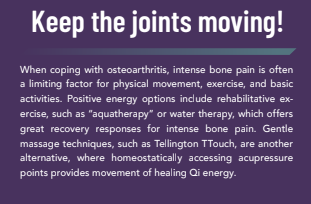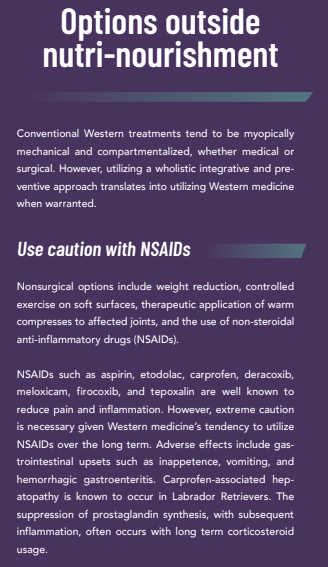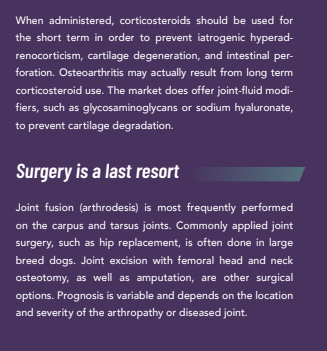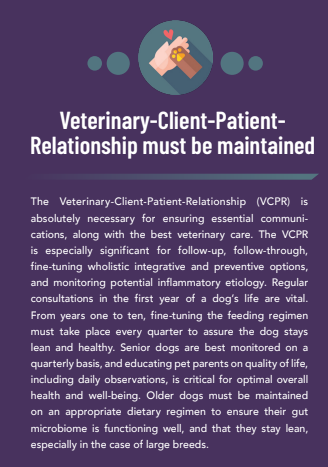Concepts such as “nutri-nourishment” are among the nutritional approaches that can successfully address osteoarthritis in dogs.
Osteoarthritis is defined as progressive deterioration of articular cartilage in diarthrodial joints. It is characterized by hyaline cartilage thinning, joint effusion, and periarticular osteophyte formation. Joint degeneration in dogs can be caused by trauma, infection, immune-mediated diseases, or developmental malformations. The etiology and inciting cause initiates chondrocyte death and necrosis, the release of degradative enzymes and synovitis, including cartilage destruction and inflammation. In this article, we look at how a nutritional approach, including the concept of “nutri-nourishment,” can help dogs with osteoarthritis.
20% of dogs have osteoarthritis
“Research shows…larger dogs are affected more than younger canines. Degenerative joint disease (DJD), as osteoarthritis (OA), is by far the most prevalent kind…. It is the friction (within the joint) that results in pain and reduced motion” (https://lanapaws.com/blogs/friends-of-lana/arthritis-in-dogs-early-signs-diagnosis-and-treatment).
“Clinical signs of degenerative joint disease include lameness, joint swelling, muscle atrophy, pericapsular fibrosis, and crepitation. Radiographic changes in the joint include joint effusion, periarticular soft-tissue swelling, osteophytosis, subchondral bone sclerosis, and possibly narrowed joint space. Arthrocentesis may be unremarkable or yield minor changes in color, turbidity, or cell counts of synovial fluid” (“Osteoarthritis,” Merck Veterinary Manual 2.1).
In reference to certain breeds, or congenital anomalies, abnormal cartilage congruence and joint capsule anatomy may lead to joint biomechanics dysfunction. Pain and lameness result, secondary to the dysfunction. Muscle atrophy may ensue, with subsequent limb disuse. Joint degeneration can often be assessed in dogs that are older or above their ideal weight.
Joint health from a wholistic integrative and preventive approach
Focusing on nutri-nourishment – i.e. nutrition that is actually nourishing — is a wholistic integrative veterinary medical practice. “Wholistic” refers to the entire being — physical body, mind, environment, and spirit. A wholistic integrative approach brings in the best of all worlds; it’s where West meets East for optimal, overall health and wellness. Nutri-nourishment is front and center of this approach, as preventive veterinary medicine.
A dog’s nutri-nourishment will provide support for osteoarthritic symptomatology, especially if it includes non-GMO, sustainably raised, organic certified ingredients void of preservatives, additives, and colorings. Most manufactured feeds contain these ingredients. Thus, it serves us to read labels and become familiar with the ingredients, especially the primary proteins. Lean novel proteins, minerals, and supplemented vitamins are necessary in the 21st century global context.
Achieving and maintaining a slim, lean, physical body is a primary foundation for optimal wellness, which includes the microbiome (prebiotics, probiotics) and gut health for the immune system (Gut Associated Lymphoid Tissue or GALT).
Veterinarians play a key role in monitoring young dogs under the age of one, and especially large breeds with a genetic tendency for hip dysplasia. It’s critical to educate clients who are looking to adopt certain breeds known to have various joint and bone deformities.

Nutrition is number one!
All veterinarians must acquire educational prowess in nutrition, which is a significant realm of animal health. Dogs are very popular as companion animals, and corporate feed companies seem to bring out new offerings on a regular basis. Most of these feeds are loaded with filler additives, preservatives, and colorings.
Here is where nutri-nourishment must be appreciated. Veterinarians and animal stewards hold the advocacy capacity to hold feed companies accountable for their product ingredients. In particular, kibble-based diets have manufactured their way into a realm of integrity that nevertheless continues to be wrought with questionable corporate practices.
Avoiding processed kibble and canned foods is highly recommended as part of a preventive approach for canine osteoarthritis.
In this article, only verified human-grade and wholistic options are considered viable options, outside of veterinarian-recommended recipes for companion animals. An age-appropriate dietary regimen for growing animals is highly recommended, and daily nutritional requirements must be compliantly adhered to for normal cellular function.
Dogs are carnivorous mammals that mostly eat meat
As predators, dogs have an innate capacity to eat prey animals. It serves to understand and appreciate which primary proteins in feed ingredients best serve companion dogs, especially during the first year of life.
For animal stewards (e.g. pet parents), supporting dogs with their carnivorous natures in mind will lead to healthy joints. Therefore, appropriate and well-thought-out nutri-nourishment, whole food supplementation, regular exercise, and weight management may prevent the onset of osteoarthritis. Ultimately, the end goal is to improve overall health and well-being.
Food ingredient options for dogs with osteoarthritis
Most of these lean novel proteins are easily found, and are bioavailable for digestive accessibility.
- Lean novel proteins, such as bison, chevron, duck, lamb, elk, venison, fish, and other game will assist in maintaining a lean body mass and provide vitamins and minerals that promote joint health.
- Oily fish, like sardines, mackerel, salmon, rohu, catla, anchovies, trout, and whitefish contain Omega-3 fatty acids, which have anti-inflammatory properties. Usually, fish comes highly recommended as a primary protein, due to its high quality beneficial properties.
- Eggs are a whole complete protein that are often overlooked when it comes to meal prep ingredients. Boiled eggs are simple to make and feed.
- Bone broth is a favorite, as it contains so many beneficial ingredients, such as collagen. Collagen is derived from the main structural proteins of skin, connective tissues, and bone. Remarkably, bone broth supports joint health, improves hydration, benefits digestion and gut health, supports immunity, and haircoat/skin health. Making bone broth, or purchasing a low-sodium, organic, grass-fed beef or bison bone broth is highly recommended.
Whole food supplements for osteoarthritis
Whole food supplements are a welcome addition to preventive care for common chronic maladies such as osteoarthritis.
- Standard Process has developed “veterinary formulas” or primary veterinary care doctors, with a great system of access for animal stewards (StandardProcess.com).
- Ayurvedic veterinary medicine offers two main options for osteoarthritis: Boswelia and Ashwagandha. Centuries of empirical wisdom have shown these herbs are beneficial for inflammation modulation and healing. Excellent results come from Ayurvedic medicine.
- New Zealand Deer Velvet [is this a product?] offers astounding healing properties for canine osteoarthritis. It is full of phenomenal nutrients and also contains green-lipped mussel and sea cucumber. It is delivered as a powder, easy and simple to mix in with food preparations.


The importance of vitamins
Vitamins are a group of essential (“vita”) organic compounds for normal growth and nutrition. They are required in relatively small quantities for digestive intake, as they are not innately formed within the physical body. Due to current unsustainable agricultural methods on a global scale, along with rapidly changing weather patterns and climate change, an understanding and appreciation of the “Soil Food Web” is crucial for supporting the availability and accessibility of vitamins in food production.
For dogs, the first year sets the foundation for a lifetime of optimal overall health and wellness. Thus, age-appropriate nutri-nourishment considerations must be communicated from veterinarians to pet parents. This preventive approach practically eliminates many common chronic ailments, such as obesity and osteoarthritis; it’s dogs above their ideal weight who are plagued with deep bone pain from sensitive joints, recognized as osteoarthritis.
Most wholistic health practitioners aware of global soil conditions highly recommend nutri-nourishment vitamin supplementation. For example, vitamins C, D, and E provide for optimal immune system response from the gastrointestinal tract’s microbiome, and a reduction of oxidative stressors to help the body move towards overall homeostasis.
Whole food supplementation is the gold standard, and far superior to fractional nutrition. Pet parents who utilize veterinary recipes must acquire the best vitamin options available. Reading labels and understanding the nutritional analyses usually provided by feed companies is very important.
- Peanut butter is fantastic for dogs, and contains vitamin E, one of the fat soluble vitamins that help minimize or prevent inflammation. Vitamin E is also essential for maintaining healthy muscles, eyes, and skin.
- Water soluble vitamin B7 helps maintain healthy skin, coat, and nails, while vitamin B3 (also water soluble) aids with fatty acid metabolism and benefits brain function.
- Yams or sweet potatoes are very valuable for nutri-nourishment. They contain antioxidant and inflammatory-modulating nutrients for osteoarthritis and overall gastrointestinal health. For pet parents making homemade recipes, avoid common seasonings and oils. Plain is perfect.
- Pumpkin is another great choice, and contains several nutrients known to have wonderful gut properties for digestion. It also modulates and reduces systemic inflammation, and offers beneficial nutrients such as beta-carotene, vitamin C, and magnesium.
Minerals matter
Minerals such as copper support a healthy immune response from the GALT as well as the total immunological system. Vital minerals must be considered in appropriate ratios, especially for the first year of a dog’s life. The calcium-to-phosphorus ratio, for instance, is essential since the musculoskeletal system takes some priority with bone and muscle growth. The ratio varies depending on the dog’s breed. It is recommended that veterinarians review the proper ratio with pet parents in order to prevent deficiencies, especially in dogs under one year of age.
Ingredients and supplements that counter or prevent inflammation
- For dogs, celery, carrots, zucchini, sweet potatoes, kale, spinach, quinoa, lentils, parsley, and apples are all part of a whole food dietary regimen that counter, or even prevent, inflammation, especially osteoarthritis. Carbohydrates with low-glycemic indices are well tolerated by the body and will modulate potential inflammation.
- Nutritional supplements, such as glucosamine and chondroitin sulfate, provide supportive cellular relief for inflammation, especially in the joints. Glucosamine is a building block for healthy cartilage cells, while chondroitin sulfate inhibits the degradation of cartilage and joint fluid enzymes.
- Cannabis tincture is well known for helping with any type of inflammatory process within the body. Many veterinarians are currently awaiting new decision-making regarding cannabis from the Drug Enforcement Agency, since this benevolent plant is still designated a controlled Schedule II drug. Most veterinarians will not discuss cannabis as a viable option, due to this legal limbo from the federal government. However, cannabis is on the horizon as “medical plant nutrition,” and its full acceptance into various markets will revolutionize pain management in both humans and animals.

- Omega-3 fatty acids, particularly eicosapentaenoic acid (EPA) and docosahexaenoic acid (DHA), are known to offer much benefit and relief from inflammatory ailments, especially in the joints. Improved mobility and movement have been readily noted in both humans and animals. Omega-3s are found in fish (e.g. sardines, salmon, mackerel, herring, krill) and seed oils (e.g. hemp, flax, algae).
- Medium Chain Triglycerides (MCT) are easily digestible and offer great potential in modulating inflammation. Coconut oil is one example. Hemp oil is another option that is gaining more popularity. Begin with small amounts, such as 1 ml per 7 kg (15 lbs) of body weight.
Given the high prevalence of osteoarthritis in dogs, it serves veterinarians well to learn as much as possible about integrative approaches to the disease, particularly the use of nutrition, to help treat or even prevent it in their patients.


